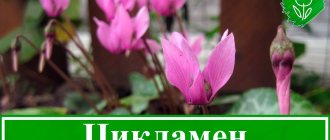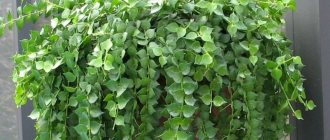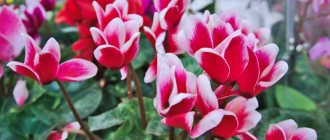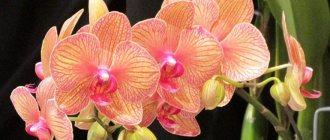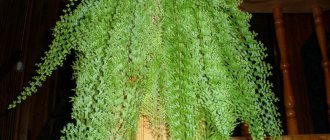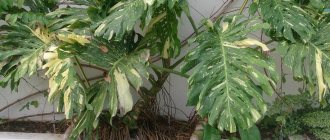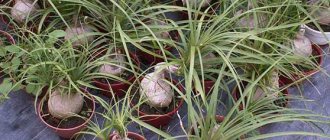Author: Elena N. https://floristics.info/ru/index.php?option=com_contact&view=contact&id=19 Category: Houseplants Published: February 12, 2019Last edits: January 11, 2021
- How to plant Guzmania
- Guzmania lingulata
In ancient times, Guzmania was considered... a vampire! As if its bright colors don’t just appear! Today it is known for certain that the guzmania plant is not a vampire, or even a parasite, but just an epiphyte. That is, it uses other plants (mainly the bark of dead trees) for support. It does not suck out any juices, but feeds with the help of funnels made from leaves. Everything else you need to know about this guest from the tropics can be found in our article.
- How to achieve the required high humidity for Guzmania at home?
- Is it true that water should be poured directly into the rosette of leaves?
- Does Guzmania really like small but heavy pots?
- Why is it not necessary to replant a flower?
- What to do with guzmania after the rosette dies?
- Under what conditions does annual guzmania “linger” for several years?
Let's figure it out together.
Planting and caring for guzmania
- Flowering: Each rosette blooms once and dies after flowering.
- Lighting: bright diffused light.
- Temperature: lower threshold – 13 ˚C, upper threshold – 27 ˚C. Optimal regime: during the period of growth and development – 25 ˚C, during the flowering period – 20 ˚C.
- Watering: as soon as signs of dryness appear on the surface of the substrate.
- Humidity: high. Requires daily spraying with settled warm water.
- Feeding: once a month from March to September with fertilizer for bromeliads, diluted twice as strong as indicated in the instructions.
- Dormant period: after flowering.
- Transplantation: do not replant.
- Reproduction: seed (very rare) and vegetative (lateral shoots).
- Pests: scale insects, mealybugs, spider mites.
- Diseases: gray rot, root rot.
Read more about growing Guzmania below.
Guzmania (lat. Guzmania) , or, as correctly, guzmania , is an evergreen herbaceous epiphytic and terrestrial plant of the Bromeliad family. The genus contains about 130 species, growing in Venezuela, Brazil, Central America, as well as in the West Indies and South Florida on open mountain slopes at an altitude of about 2400 m above sea level. This genus was first described in 1802, and the name Guzmania was given in honor of the Spanish botanist, zoologist and pharmacist Anastasio Guzman, who studied South America. Since then, many Guzmania species have been cultivated for indoor floriculture. Indoor guzmania is attractive with its unusual rosette of long leaves and an unusual cone-like inflorescence, but the most important advantage is the long flowering of guzmania.
Main characteristics
Guzmania is a herbaceous plant that belongs to the Bromeliads, that is, it is a relative of the pineapple. Its homeland is considered to be the rainforests of India, Brazil, America and Venezuela.
The genus was named in honor of the Spaniard Guzman, who first described this plant in detail, and in botanical nomenclature it correctly sounds like “Guzmania”. But due to an incorrect reading of the Latin version, the name “Guzmania” stuck, which is now used even by some experts.
Since the flower is an epiphyte, the root system is not very developed. Nutrition occurs partially through a cup at the base of the rosette, in which moisture accumulates. The supply of water in nature is used not only by plants, but also by many birds or insects that use such natural reservoirs to quench their thirst.
The culture is valued for its long decorative flowering, which lasts up to four months.
It first appears at the age of 4-6 years. The bright top is not actually a flower, it is modified leaves that become brightly colored to attract pollinators to the very small and inconspicuous reproductive flowers. In some species, cleistogamy is observed, that is, the bud never opens, and self-pollination occurs inside it at this time. After flowering, the flower dies after about six months.
Botanical description
Like all bromeliads, guzmania leaves overlap each other at the base, forming a cup for water, which the plant accumulates for itself, but is also used by other forest inhabitants. Typically, guzmania leaves are monochromatic, but there are species with longitudinally or transversely striped leaves. The leaves, reaching a length of 40 to 70 cm, form a rosette with an average diameter of half a meter, although there are both more compact species and smaller ones. The situation is the same with the peduncle: different species have different lengths.
- Dizygotheca – care, photos, types
The guzmania plant blooms in March or September and blooms for several months. The flowers are unattractive and inconspicuous, but the bright, varnished red, yellow, white or orange bracts 4-5 cm long, forming an unusual inflorescence, are extremely impressive. An adult plant reaches 75 cm in height and 60 cm in width, but homemade guzmania rarely grows above 40 cm. The plant dies within six months after flowering.
Caring for Guzmania at home
Growing conditions
Caring for Guzmania requires special knowledge, which we will try to share with you. The plant loves warmth and moist air, diffused light without direct sunlight. When guzmania is preparing to flower, it will require an air temperature of at least 25 ºC, but an already flowering plant needs 20 ºC. The lower threshold that guzmania can withstand for a short time is 13 ºC, and despite its love of warmth, do not keep it for a long time at temperatures above 27 ºC, because guzmania may die.
To achieve the high air humidity required by the plant at home, you will have to spray it daily with distilled or at least filtered water, and from October to February you need to spray it only in the morning. During spraying, water should not get on the bracts, because this greatly shortens the flowering time.
How to water
Since the roots of all bromeliads are very sensitive to chlorine and lime, they can only be watered and sprayed with filtered, or even better, distilled warm (20 ºC) water. The frequency of watering should be such that the substrate does not dry out: water as soon as signs of drying appear on the surface of the substrate. Water should be poured directly into the rosette of leaves.
How often you will need to water your guzmania depends on the conditions you are able to create for it. If the lighting and air temperature are lower than recommended, then the guzmania will have to be watered less often, but daily spraying of the leaves with warm water is mandatory in any case. Guzmania especially needs moisture in spring and summer, during the period of active growth.
Top dressing
Fertilizer for bromeliads is sold in specialized stores, but when feeding, the concentration should be half that recommended by the manufacturers. Make sure that the fertilizer does not contain boron or copper, which are toxic to guzmania. The plant needs to be fertilized once a month from March to September. Fertilizer is applied during watering directly into the guzmania rosette or while spraying on the leaves.
- Homemade aloe
Possible problems
- Excessive watering may cause root rot .
- Guzmanias are often affected by fungal diseases due to being kept in too warm and humid rooms.
- Brown spots on the leaves indicate sunburn.
- The tips of the leaves turn brown when there is insufficient air humidity, as well as watering with hard water or the lack of the required amount of water in the outlet.
- The death of the plant after flowering is completed is a natural process.
- The appearance of yellow spots on the leaves with gradual yellowing and death of the leaf as a whole indicates a red spider mite infestation.
- The appearance of brown plaques-tubercles on the leaves - the plant is affected by bromeliad scale.
- If the leaves are covered with a white cotton wool-like fluff , it means that mealybugs have occurred.
- If the plant does not form daughter plants , it means it does not have enough nutrients.
- Drooping and soft leaves indicate a low temperature for keeping Guzmania.
Guzmania transplant
It is unlikely that you will need information on how to replant guzmania, because it is replanted only once: from the pot in which you brought it from the store to a permanent one. If necessary. Guzmania's root system is shallow, so the pot you move it into should be no more than 10-12 cm in diameter. Try to weigh the pot down with something, as the plant may tip it over. Or place the potted plant in a decorative planter for stability. Don't forget about the drainage layer.
The substrate needs to be water-permeable, acidity in the range of 5.5-7.0. Here are the approximate composition options:
- crushed roots of sphagnum moss and fern in a ratio of 1:3;
- moss, sand, pine bark, leaf soil in a ratio of 1:1:2:2;
- sand, humus, turf soil, peat in the ratio 1:2:2:4,
although you can use commercially available fern or orchid substrate. Prepare a pot with drainage, pour some substrate into it, transfer the plant from the old pot to the new one along with a lump of earth and add more substrate. Nothing complicated. Just be careful with fragile roots.
Can a flower be dangerous?
Just as guzmania enhances all positive energy in the home, it can do the same with negative emotions:
- if you are experiencing discomfort at home, do not want to return, feel out of place and may even be thinking about moving, then these are negative signs that the guzmania flower makes you feel;
- if people are prone to aggression, anxiety, and often get angry, then according to superstition, flower culture will lead to a multiple exaggeration of the manifestation of these feelings;
- They believe that guzmania is a magnet for uninvited visitors and even ill-wishers, however, it only has this effect on closed and unfriendly hosts.
Reproduction of Guzmania
How to plant Guzmania
In this chapter we will answer the questions of how to propagate Guzmania at home, how to plant Guzmania babies and how to divide Guzmania, because this is the same process. Guzmania reproduces at the end of flowering by lateral shoots, which are called children.
When guzmania fades, the mother rosette dies, but guzmania babies appear around it, growing their own roots as they grow older. As soon as the roots reach a length of 1.5 cm, you need to separate the shoot with a sharp sterile instrument from the mother plant, treat the cut on the baby and on the old guzmania with garden varnish. Not all children develop roots at the same time, so it is unlikely that it will be possible to plant all the children at one time.
The separated shoots are transplanted into pots with a substrate for orchids and kept warm, at first under a plastic cap to increase the air humidity necessary for growing guzmanias. When the plants get stronger and grow, they are transplanted into permanent pots using the transshipment method, so as not to damage the brittle roots.
Growing from seeds
Guzmania also reproduces by seeds. This is done like this: on the surface of the soil for bromeliads, consisting of crushed peat mixed with sand, seeds are sown, previously washed in a solution of potassium permanganate and dried. There is no need to embed them in the ground, since the seeds must germinate in the light, but it is necessary to cover the container with glass or film.
The temperature for seed germination should be 22-24 ºC, the seeds are ventilated as necessary and lightly sprayed with warm water.
- Photo of Amaryllis Belladonna
Shoots should appear in two to three weeks, and after 2-2.5 months they are planted in soil consisting of leaf soil, turf soil and peat in a ratio of 2:1:4. After six months, the young plants are planted in permanent pots. These guzmanias will bloom in three, four years, or even five years.
Kinds
Guzmania lingulata
Among the indoor species of guzmania, the most widely represented is guzmania reed - a plant that can exist as an epilith (grow on rocky soil) and as an epiphyte. The base of the flower is a rosette of dense and long green wide-line leaves, in the center of which there is a corolla of brightly colored bracts that can be mistaken for a flower. In fact, the flowers, collected in spike-shaped inflorescences, are completely inconspicuous and bloom for only a short time.
Varieties of Guzmania reed:
- var. cardinalis (“purple”) - a variety with a spreading rosette of green leaves 3-4 cm wide, scarlet, red or purple bracts, multi-flowered inflorescence. Blooms in March, September;
- var. concolor (“modestly colored”) - a rosette of light green leaves, faded orange bracts with brighter tips;
- var. flammea (“fire”) is a rosette of green leaves about 24-34 cm long and 1-2 cm wide, which are directed in all directions of the upper hemisphere. Fiery red bracts reach to the zenith. The inflorescence is small-flowered, blooms in July and August;
- var. lingulata (“ordinary”) – leaves in a rosette 2.5 cm wide, erect bracts of red or pink color, blooms in March, August and December;
- var. minor (“small”) - a rosette of green or red-green leaves 2.5 cm wide, the inflorescences are erect or spreading, lemon-yellow and red.
In the photo: Guzmania lingulata
Guzmania donnellsmithii
It is a loose rosette of green leaves with pale scales. The peduncle is erect, the short inflorescence is pyramidal-paniculate, covered at the base with bright red imbricated bracts. Blooms in April, May.
Blood red Guzmania (Guzmania sanguinea)
A goblet-shaped rosette of broadly linear leaves, thin bracts of a bright red hue, the corymbose inflorescence has a leaf-shaped involucre and is literally immersed in the rosette due to an undeveloped peduncle.
Varieties of Guzmania blood-red:
- var. Sanguinea (“bloody”) - round bracts with a sharp end, flower petals are yellow with green or white, blooms in April, August;
- var. Brevipedicellata (“short-legged”) is a species with pointed, helmet-shaped bracts.
In the photo: Blood red Guzmania (Guzmania sanguinea)
Guzmania musaica, or mosaic (Guzmania musaica)
A plant with long leaves forming a spreading rosette, a straight peduncle, on which broadly elliptical, pointed bright pink stipules. Two dozen whitish-yellow flowers are collected in a simple capitate inflorescence, the base of which is hidden by stipules.
Varieties:
- var. Musaica - light green leaves, streaked with irregular lines, blooms in June, September;
- var. Concolor – leaves are one color;
- var. Zebrina – leaves with wide stripes.
In the photo: Guzmania musaica, or mosaic (Guzmania musaica)
Nicaraguan Guzmania (Guzmania Nicaraguensi)
It is interesting for its tongue-shaped leaves, narrowed towards the ends, which are covered along the lower part with pale dense scales, disappearing as the guzmania grows. Instead of scales, small longitudinal red streaks remain on the leaves. The rosette formed by the leaves has the shape of a glass, in which a simple spindle-shaped inflorescence with a small number of yellow flowers is immersed. Blooms in March, May.
Guzmania monostachia
The rosette consists of numerous yellow-green leaves, the lower ones being paler than the upper ones and in some places covered with small pinpoint scales that gradually fall off. The bare peduncle is crowned by a multi-row elongated spike of white flowers; the bracts of fruit-forming flowers are pale with brown longitudinal marks; those of sterile flowers are bright red or white.
Varieties:
- var. Monostachia - single-color leaves, pale-colored bracts with chocolate-colored longitudinal strokes, blooms in June, July;
- var. Variegata - green leaves with white streaks;
- var. Alba - single-color green leaves, the lower bracts are also green, the upper ones are white.
In the photo: Guzmania monostachia
Guzmania zahnii
- a giant flower with leaves up to 70 cm long.
FAQ
Why does guzmania lose color? To prevent guzmania bracts from turning pale, provide the plant with bright light and good nutrition. Place the flower pot on a bright windowsill, providing protection from direct sunlight: the light should be diffused. And to fertilize the soil, purchase a mineral complex for bromeliads and feed guzmania as indicated in the instructions. Guzmania leaves turn yellow - why?
There may be several reasons why guzmania leaves turn yellow.
Nutrient deficiency in the soil: this causes the plant to stop growing, and its leaves turn pale and yellow. Don't forget to feed your guzmania with bromeliad fertilizer.
This may be a reaction to overwatering or improper watering. Under natural conditions, guzmania retains moisture in the rosette, but in indoor culture it receives water of a completely different quality, so it is better to moisten the substrate rather than pour water into the rosette. Excessive watering leads to rotting of the plant.
The leaves turn yellow if the guzmania is parasitized by scale insects. Pick up the pests by hand and wash the leaves with soapy water, being careful not to get it into the outlet. If necessary, treat the guzmania with an insecticide.
The plant may be suffering from a fungal infection.
Transplant the plant into a fresh substrate, treating the roots with a solution of potassium permanganate, and then carefully monitor the condition of the guzmania. What to do if guzmania dries out?
Inspect the rosette of the guzmania: it can rot, and as a result, not only the leaves, but also the peduncle will dry out. To properly water bromeliads in a rosette, you need to have certain skills, and if you do not know how to do this, then it is better to moisten the substrate in the pot.
In a room where the air is too dry, the tips of guzmania leaves may dry out.
Spray the leaves with warm water, being careful not to let the spray fall on the flowers and stipules. Wash the leaves with warm water once a week. Place containers of water around the plant to saturate the air with moisture. Why doesn't Guzmania grow?
If an adult Guzmania's growth has stopped, it may be because it lacks nutrition or is unhappy with its conditions. Or maybe she's just getting ready to bloom.
If we are talking about the development of abandoned children, then their slow growth is quite normal: they can sit in the ground without external changes for up to six months or longer. Keep them in a warm place, water them with warm water, but do not feed them: fresh substrate contains enough nutrients for young plants. You can hold a pot of young guzmania in a bowl of hot water, after placing a layer of drainage material on the bottom. As soon as the water cools down, change it to hot, and so on 3-4 times a day.
All this time, keep the children under a hood: it will protect them from possible temperature changes.
Remove it when they begin to grow. Where is the best place to keep Guzmania in an apartment?
When choosing a place for guzmania, proceed from the fact that it requires warmth, diffused light and slightly increased air humidity. During flowering, the plant releases substances that have bactericidal properties, but in allergy sufferers they can provoke an exacerbation, accompanied by drowsiness and malaise. The milky juice of guzmania, if it comes into contact with the skin, can also cause an allergic reaction or irritation.
Healthy people can keep guzmania in the bedroom, and feng shui experts recommend that couples place this plant on both sides of the bed as a symbol of couples.
Many people prefer to decorate the kitchen with guzmania: it is warm, light, and the air is saturated with moisture. Guzmania is covered in mold - what to do?
Mold on guzmania is a sign of a fungal disease that can develop from excessive or improper watering, as well as due to the lack of a drainage layer in the pot, acidic soil (almost all indoor plants prefer neutral soil) or too high air humidity.
Inspect the plant - leaves, rosette, roots, and if the guzmania has not yet died, remove all rot from it, cut off the peduncle, and cauterize the wounds with colloidal sulfur, then plant the plant in a fresh substrate for bromeliads.
Eliminate mistakes in caring for guzmania, in particular, do not pour water into the outlet, but moisten the substrate. The first time after transplantation, add Ribav or Epin to the watering water to stimulate the formation of daughter rosettes. How to make Guzmania bloom?
Sometimes guzmania does not form a peduncle for several years in a row. This happens due to a deficiency of macro- and microelements in the soil, poor lighting, insufficient moisture or other reasons. Analyze whether you are doing everything correctly, eliminate all your shortcomings and mistakes, and Guzmania will definitely bloom.
You can stimulate the formation of a flower arrow in this way: place a piece of rotting apple on the surface of the substrate and cover the flower pot with a transparent bag. Apples produce acetylene, which accelerates the development of tropical plants. Remember that the bag needs to be removed briefly every day for ventilation. It is better to use garden apples rather than store-bought ones: imported fruits usually wither, but do not rot.
As soon as you notice that the guzmania has a flower shoot, remove the apple and remove the bag.
How often does Guzmania bloom?
The Guzmania rosette blooms only once. After flowering, it dies, forming daughter rosettes that can be separated, rooted and planted in special soil for bromeliads. This is how Guzmania reproduces.
You should also know that guzmanias don't bloom until they reach four years of age, so don't panic and just wait.
If you create the necessary conditions for young guzmanias - timely and sufficient watering, bright diffused light, slightly increased air humidity and regular feeding, they will definitely bloom. What causes guzmania?
Guzmania can be affected by fungal infections, for example, sooty fungus and root rot, which develop against the background of excessive or improper watering and temperature disturbances. As a result, rotting of both the ground organs of the guzmania and the roots may begin. Unfortunately, often these changes are detected too late, when guzmania can no longer be saved. In addition, bromeliads react painfully to fungicide treatment. It is easier to prevent a fungal disease than to cure it: try to create optimal conditions for your guzmania and provide it with proper care.
If Guzmania leaves are exposed to sunlight, burns may occur.
This can be avoided by shading the plant from direct sun from noon to 4 pm with a light curtain. What pests live on Guzmania?
Scale insects, mealybugs, aphids and spider mites can parasitize Guzmania. Scale insects and their secretions must be manually removed from the leaves with a cotton swab dipped in a soap solution (7 g of liquid soap per 1 liter of water), after which the guzmania should be treated with a solution of Fitoverm, Karbofos or another preparation of similar action.
Aphids are carriers of viral diseases and sooty fungus spores. The pest is destroyed by treating guzmania leaves with an infusion of 25 g of onion (garlic) in 1 liter of water. Among insecticides, Aktara, Fitoverm and Iskra work well against aphids.
Spider mites occupy the plant in conditions of low air humidity. Wash the guzmania under running warm water, then soap the leaves with laundry soap, and after a few minutes, rinse it off. When the plant dries, spray it with Actellik or Fitoverma solution.
Where is the best place to put a flower?
To improve relationships in all directions, spouses are recommended to place a pot of guzmania in the bedroom, but under one condition: there must be two plants. They say that in the bedroom all objects should be paired, which will personify the well-being of each of the couple. It is also recommended to place plants opposite each other.
Another good place for Guzmania would be the south-eastern space of your house or apartment, as this is the area of love and marriage. The eastern zone is responsible for the development and health of residents, where it will also perform well.
